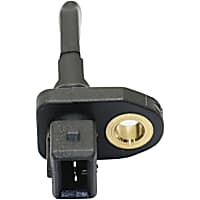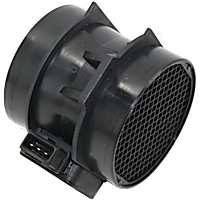The P0114 engine code indicates that there is a potential issue with your vehicle’s intake air temperature sensor or its circuit. Learn more about this trouble code’s definition, causes, and symptoms with this brief guide.
What Does the P0114 Code Mean?
Diagnostic trouble code (DTC) P0114 stands for “Intake Air Temperature Intermittent/Erratic (Bank 1).” This trouble code sets when the powertrain control module (PCM) has detected an intermittent or erratic input signal from the intake air temperature (IAT) sensor circuit over a predetermined amount of time. If the vehicle has two coolant temperature sensors, the ‘1’ portion of the code points to sensor # 1. Bank 1 refers to the side of the engine with the #1 cylinder.

The intake air temperature sensor measures the air temperature entering the intake manifold. The PCM uses the input signal from the intake air temperature sensor to calculate the ignition timing strategy, fuel delivery, and many components of the emissions control system. As such, the P0114 code should be addressed immediately and treated as a severe code.
The intake air temperature sensor is positioned so that while the engine is running, the ambient air drawn into the intake manifold can flow continuously through the sensor. That’s why the intake air temperature sensor is often found in the intake manifold. However, it can also be inserted into the air inlet pipe or air cleaner box or integrated into the mass air flow (MAF) sensor housing.
The intake air temperature sensor is usually a two-wire thermistor. This means that the sensor’s resistance varies according to the temperature of the air that flows through its cold wire element. When the sensor reads cold, its resistance is high, but when the sensor reads warm, its resistance is low.
Varying resistance levels in the sensor element can cause voltage fluctuations in the input circuit. The PCM may interpret these changes as variations in the intake air temperature. The P0114 code is stored if the PCM notices these intermittent signals for a specific period of time.
Our in-depth look at the IAT sensor and how it can cause OBD codes to appear can help you understand P0114 better.
Note: The definition of code P0114 may be different depending on the vehicle manufacturer. Consult the appropriate repair manual or repair database for the exact code definition.
What are the Possible Causes of the P0114 Code?
There are many likely reasons why diagnostic trouble codes set. DTCs, such as the P0114 code, are only able to indicate the nature and location of the potential issue, not the root cause itself. Listed below are just some of the possible causes of the P0114 engine code:
- IAT circuit intermittent open
- IAT circuit intermittent short to voltage
- IAT circuit intermittent short to ground
- Damaged IAT sensor
- Damaged harness connector
- Damaged harness
- Faulty MAF sensor

What are the Common Symptoms of the P0114 Code?
When a DTC sets, the vehicle’s computer sends a signal to illuminate the malfunction indicator lamp (MIL). In some cases, this may be the only indicator of a potential problem. However, for many DTCs, there may also be other signs present. Below are some of the common symptoms you may notice if you’re dealing with the P0114 code:
- Malfunction indicator lamp (MIL) or check engine light on
- Poor fuel economy
- Poor engine performance
- Hesitation or surge at idle or on acceleration
- In some cases, the engine may be hard starting
- Other drivability codes may also be stored
How to Diagnose the P0114 Code
Diagnosing DTCs involves a lot of time and effort because one has to narrow down the root cause from a list of possible causes. While the process seems intimidating, it’s definitely possible with the right tools and resources.
Vehicle-specific repair manuals or databases are great sources of information because they have detailed instructions and helpful illustrations. Technical service bulletins (TSBs) are also important resources, as they contain the manufacturer’s suggested fixes for certain issues and DTCs. There are also other alternative sources you can use online, such as how-to videos and blogs.
How to Fix the P0114 Code
Disclaimer: Due to the wide variability in vehicle makes and models, as well as other factors, the following information must not be construed as complete or the only definitive way to address a particular issue. Instead, the following content merely attempts to give you a better idea of what a do-it-yourself approach to the issue might involve. You are encouraged to find more technical resources regarding the subject or take your vehicle to a professional technician for the best results.
Troubleshooting DTCs is a challenging task mainly for two reasons. The first is that you have to determine the main reason why a code is set. This isn’t easy, as there may be quite a few possible reasons why trouble codes are stored.
The second reason is that vehicles differ according to their manufacturer. Certain components, terminology, and predetermined values vary. For example, the setting conditions of the P0114 on a Chevy differ greatly from the setting conditions of P0114 on Ford vehicles.
Check the Technical Service Bulletins
Before diagnosing and working on the code, it’s best to check the technical service bulletins (TSB) of your vehicle first. The TSB lists known issues and errors, as well as fixes put out by the manufacturer. It’s possible P0144 is among the issues listed there.
Clear the Codes
Try clearing the codes and test-driving the vehicle. To do this, you’ll need an OBD-II scanner and to follow the steps below:
- Step 1: Plug the OBD scanner into the OBD port under the steering column.
- Step 2: Turn the vehicle on (don’t start it) and press the read button on your scanner.
- Step 3: Press the erase/clear button on your scanner, then turn your vehicle off.
After clearing the code, you’ll want to store them and the applicable freeze frame data. Use a modern scan tool to check the data and compare the results to the factory services literature. Afterward, test drive the vehicle to ensure everything is functioning as intended.
Scan Tool Test from Richard McCuistian, ASE Certified Master Automobile Technicians

With the vehicle parked a few hours, the ECT and IAT readings should be very near the same. If they’re not, then perform this test.
With the sensor unplugged, a scan tool reading the enhanced data stream (not the generic one) will typically read about 101 F on the disconnected sensor.
With a 50k potentiometer connected at the sensor plug (backprobe so as not to damage the terminals), you can dial in a temperature that matches and recheck for a code.
Visual Inspection
Try inspecting the IAT sensor and its related wiring and connectors (including the air filter and the air inlet pipe) for short circuits and corroding. Replace the necessary components and run a quick test drive to examine everything.
Replace the Harness and Harness Connectors
Try and look for damaged harnesses and harness connectors attached to the IAT and MAF, if applicable. It’s crucial to replace damaged ones as soon as possible, as it may affect other connected components.
The price of new harness connectors should cost less than $10.
Replace the MAF or IAT Sensors
If the MAF or IAT is causing the issue, then replacement for one or both is worth considering. To properly remove and replace them, refer to the steps below:
- Step 1: Disconnect the MAF and IAT sensors connector.
- Step 2: Remove the screws holding the sensors in place.
- Step 3: Remove the MAF and IAT sensors.
- Step 4: Install the parts by following the steps in reverse.
While repair manuals and other resources can help an experienced DIYer, consulting a licensed mechanic or technician is recommended, especially if one doesn’t have much knowledge in fixing trouble codes.
Other Notes About P0114
Technical Service Bulletins (TSBs) are helpful if you’re trying to diagnose or fix the P0114 code. These bulletins contain information on how to address certain issues and DTCs affecting several vehicle models.
In fact, there is a TSB tackling the P0114 code on 2013 Ford F-150 vehicles. Ford’s TSB 14-0075 suggests that reprogramming the PCM to its latest calibration will be able to fix the P0113 and/or P0114 DTCs on the aforementioned models.
Where To Find a Quality Replacement IAT Sensor
A faulty IAT sensor will most likely cause your vehicle to use up more gas, and that’s just the tip of the iceberg. Ignoring the underlying issues triggering the P0114 code can damage your engine, leading to costly repairs down the line. To prevent this, you should replace your IAT sensor as soon as possible. Thankfully, you can get a quality replacement at CarParts.com in no time.
With strategically located warehouses all over the US, CarParts.com guarantees efficient order processing and fast shipping. If you order before 12 PM ET, you can even expect your order to arrive in as fast as two business days. You can also expect nothing but the best IAT sensors when browsing through our catalog, as we only source our products from the most trusted manufacturers in the industry.
Don’t let your vehicle suffer any longer and order a new IAT sensor at CarParts.com now.
Products Mentioned in this Guide
Any information provided on this Website is for informational purposes only and is not intended to replace consultation with a professional mechanic. The accuracy and timeliness of the information may change from the time of publication.


 IAT Sensor
IAT Sensor
 Mass Air Flow Sensor
Mass Air Flow Sensor
















